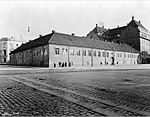The Faculty of Law (Norwegian: Det juridiske fakultet) of the University of Oslo is Norway's oldest law faculty, established in 1811 as one of the four original faculties of The Royal Frederick University (renamed the University of Oslo in 1939). Alongside the law faculties in Copenhagen, Lund and Uppsala, it is one of Scandinavia's leading institutions of legal education and research. The faculty is the highest-ranked institution of legal education in Norway and is responsible for the professional law degree, one of the most competitive programmes at any Norwegian university.
Prior to 1811, the University of Copenhagen was the only university of Denmark-Norway, and the curriculum of the new law faculty in Christiania (renamed Oslo in 1925) was based on that of the University of Copenhagen Faculty of Law and long retained strong similarities, even after the dissolution of the Dano-Norwegian union in 1814. As the only faculty of law in Norway until 1980, it traditionally educated all lawyers of Norway and remains the country's most important law faculty, educating around 75% of all new legal candidates in Norway. Its law programme is one of the most competitive programmes to get into at any Norwegian university, with an acceptance rate of 12%. The faculty offers education and conducts research in both law and in related areas such as criminology and sociology of law, and historically also in economics (its former Dean, Ragnar Frisch, was awarded the first Nobel Memorial Prize in Economic Sciences).
The faculty occupies the old university campus in the centre of Oslo, near the National Theatre, the Royal Palace, and the Parliament, constructed 1841–1851 by Christian Heinrich Grosch with the assistance of world-famous Prussian architect Karl Friedrich Schinkel in Schinkel's neoclassical style, with strong similarities to Schinkel's famous museums on the Museum Island in Berlin. The old campus includes three main buildings, called Domus Academica, Domus Media and Domus Bibliotheca, centered on the University Square and facing Karl Johans gate. It is complemented by the new building Domus Juridica in the opposite direction, located between the Old National Gallery and the Museum of Cultural History, facing the old campus.
The Nobel Peace Prize was awarded in the atrium of the central building of the old campus, Domus Media, 1947–1989 and in 2020. The Parliament of Norway convened in the Old Ceremonial Hall in Domus Academica 1854–1866. The faculty publishes several academic journals, including the English-language journal Oslo Law Review.










